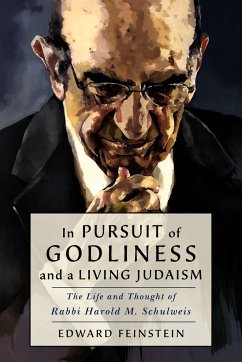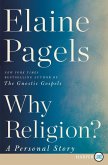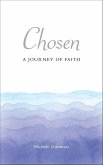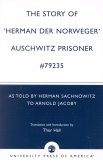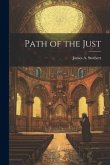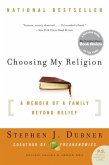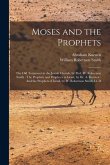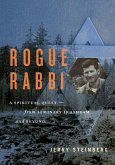Edward M Feinstein
In Pursuit of Godliness and a Living Judaism
The Life and Thought of Rabbi Harold M. Schulweis
18,99 €
inkl. MwSt.
Versandfertig in über 4 Wochen

9 °P sammeln
Edward M Feinstein
In Pursuit of Godliness and a Living Judaism
The Life and Thought of Rabbi Harold M. Schulweis
- Broschiertes Buch
- Merkliste
- Auf die Merkliste
- Bewerten Bewerten
- Teilen
- Produkt teilen
- Produkterinnerung
- Produkterinnerung
A comprehensive biography about the life and work of Rabbi Harold Shulweis who was essential in the renewal of Jewish life in post-war America.
Andere Kunden interessierten sich auch für
![Why Religion? Why Religion?]() Elaine PagelsWhy Religion?25,99 €
Elaine PagelsWhy Religion?25,99 €![Chosen Chosen]() Michele GuinnessChosen15,99 €
Michele GuinnessChosen15,99 €![The Story of 'Hernan Der Norweger' Auschwitz Prisoner #79235 The Story of 'Hernan Der Norweger' Auschwitz Prisoner #79235]() The Story of 'Hernan Der Norweger' Auschwitz Prisoner #79235113,99 €
The Story of 'Hernan Der Norweger' Auschwitz Prisoner #79235113,99 €![Path of the Just Path of the Just]() James A. StothertPath of the Just36,99 €
James A. StothertPath of the Just36,99 €![Choosing My Religion Choosing My Religion]() Stephen J DubnerChoosing My Religion18,99 €
Stephen J DubnerChoosing My Religion18,99 €![Moses and the Prophets: The Old Testament in the Jewish Church, by Prof. W. Robertson Smith: The Prophets and Prophecy in Israel, by Dr. A. Ku Moses and the Prophets: The Old Testament in the Jewish Church, by Prof. W. Robertson Smith: The Prophets and Prophecy in Israel, by Dr. A. Ku]() Abraham KuenenMoses and the Prophets: The Old Testament in the Jewish Church, by Prof. W. Robertson Smith: The Prophets and Prophecy in Israel, by Dr. A. Ku28,99 €
Abraham KuenenMoses and the Prophets: The Old Testament in the Jewish Church, by Prof. W. Robertson Smith: The Prophets and Prophecy in Israel, by Dr. A. Ku28,99 €![Rogue Rabbi Rogue Rabbi]() Jerry SteinbergRogue Rabbi23,99 €
Jerry SteinbergRogue Rabbi23,99 €-
-
-
A comprehensive biography about the life and work of Rabbi Harold Shulweis who was essential in the renewal of Jewish life in post-war America.
Hinweis: Dieser Artikel kann nur an eine deutsche Lieferadresse ausgeliefert werden.
Hinweis: Dieser Artikel kann nur an eine deutsche Lieferadresse ausgeliefert werden.
Produktdetails
- Produktdetails
- Verlag: Turner Publishing Company
- Seitenzahl: 288
- Erscheinungstermin: 4. Februar 2020
- Englisch
- Abmessung: 229mm x 152mm x 23mm
- Gewicht: 408g
- ISBN-13: 9781684424344
- ISBN-10: 1684424348
- Artikelnr.: 56719703
- Herstellerkennzeichnung
- Libri GmbH
- Europaallee 1
- 36244 Bad Hersfeld
- gpsr@libri.de
- Verlag: Turner Publishing Company
- Seitenzahl: 288
- Erscheinungstermin: 4. Februar 2020
- Englisch
- Abmessung: 229mm x 152mm x 23mm
- Gewicht: 408g
- ISBN-13: 9781684424344
- ISBN-10: 1684424348
- Artikelnr.: 56719703
- Herstellerkennzeichnung
- Libri GmbH
- Europaallee 1
- 36244 Bad Hersfeld
- gpsr@libri.de
Rabbi Edward Feinstein is senior rabbi of Valley Beth Shalom in Encino, California. He is an instructor in the Ziegler Rabbinical School of American Jewish University and the Wexner Heritage Program. He is the author of Tough Questions Jews Ask: A Young Adult's Guide to Building a Jewish Life (Jewish Lights) and Capturing the Moon; and the editor of Jews and Judaism in the 21st Century: Human Responsibilities, the Presence of God, and the Future of the Covenant (Jewish Lights). He contributed to May God Remember: Memory and Memorializing in Judaism¿Yizkor; Who by Fire, Who by Water¿Un'taneh Tokef and We Have Sinned: Sin and Confession in Judaism ¿Ashamnu and Al Chet (all Jewish Lights).
Contents Acknowledgements Introduction Part One: The American Jewish Experience Chapter 1 The American Rabbi, a Brief History 1.1 The First American Rabbis 1.2 The Golden Age of the American Rabbinate, 1918
1950 1.3 The New Rabbinate, the New Synagogue, the New Judaism 1.4 Zionism and Power 1.5 Political Power 1.6 The Dynamic Rabbinate Chapter 2 Three Languages, Three Voices 2.1 Identity: Speaking Three Languages 2.2 Formation 2.3 Family 2.4 Oakland, California, 1952
1970 The Theological Voice The Prophetic Voice The Voice of Community Building New Narratives 2.5 Transition Chapter 3 Encino, 1970 3.1 The Resurgence of Los Angeles Jewry 3.2 A Congregation of Newcomers 3.3 The Suburban Paradise 3.4 Hear Me Roar 3.5 Is That All There Is? 3.6 Encino Jews Part Two: Three Rabbinic Voices Chapter 4 The Theological Voice 4.1 The Rabbi as Theologian 4.2 The Theologian as Rabbi 4.3 The Failure of Theodicy Classical Metaphysical Theologies: Aquinas and Maimonides Hartshorne
s Process Theology Personalist Theologies: Buber and Barth The Eternal Question
Why Me? 4.4 Predicate Theology Sources Answering Evil Revelation Oneness Prayer Godliness or Goodness? I Seek a God I Can
t Believe In 4.5 Two Names for God 4.6 God and the Holocaust Chapter 5 The Prophetic Voice 5.1 The Rabbi as Prophet 5.2 The 1970s: The Holocaust Dybbuk 5.3 The 1980s: Out of the Cave 5.4 The 1990s: The Stenosis of Halachah 5.5 2000: The Duty to Obey, the Duty to Disobey Chapter 6 The Voice of Community Building 6.1 The Psychological Jew 6.2 Mediating Structures: The Synagogue Havurah 6.3 Mediating Structures: Para-Rabbinics 6.4 Poetry 6.5 Reinventing the Rabbinate 6.6 Shaping New Narratives Epilogue A Note on Sources Works Cited
1950 1.3 The New Rabbinate, the New Synagogue, the New Judaism 1.4 Zionism and Power 1.5 Political Power 1.6 The Dynamic Rabbinate Chapter 2 Three Languages, Three Voices 2.1 Identity: Speaking Three Languages 2.2 Formation 2.3 Family 2.4 Oakland, California, 1952
1970 The Theological Voice The Prophetic Voice The Voice of Community Building New Narratives 2.5 Transition Chapter 3 Encino, 1970 3.1 The Resurgence of Los Angeles Jewry 3.2 A Congregation of Newcomers 3.3 The Suburban Paradise 3.4 Hear Me Roar 3.5 Is That All There Is? 3.6 Encino Jews Part Two: Three Rabbinic Voices Chapter 4 The Theological Voice 4.1 The Rabbi as Theologian 4.2 The Theologian as Rabbi 4.3 The Failure of Theodicy Classical Metaphysical Theologies: Aquinas and Maimonides Hartshorne
s Process Theology Personalist Theologies: Buber and Barth The Eternal Question
Why Me? 4.4 Predicate Theology Sources Answering Evil Revelation Oneness Prayer Godliness or Goodness? I Seek a God I Can
t Believe In 4.5 Two Names for God 4.6 God and the Holocaust Chapter 5 The Prophetic Voice 5.1 The Rabbi as Prophet 5.2 The 1970s: The Holocaust Dybbuk 5.3 The 1980s: Out of the Cave 5.4 The 1990s: The Stenosis of Halachah 5.5 2000: The Duty to Obey, the Duty to Disobey Chapter 6 The Voice of Community Building 6.1 The Psychological Jew 6.2 Mediating Structures: The Synagogue Havurah 6.3 Mediating Structures: Para-Rabbinics 6.4 Poetry 6.5 Reinventing the Rabbinate 6.6 Shaping New Narratives Epilogue A Note on Sources Works Cited
Contents Acknowledgements Introduction Part One: The American Jewish Experience Chapter 1 The American Rabbi, a Brief History 1.1 The First American Rabbis 1.2 The Golden Age of the American Rabbinate, 1918
1950 1.3 The New Rabbinate, the New Synagogue, the New Judaism 1.4 Zionism and Power 1.5 Political Power 1.6 The Dynamic Rabbinate Chapter 2 Three Languages, Three Voices 2.1 Identity: Speaking Three Languages 2.2 Formation 2.3 Family 2.4 Oakland, California, 1952
1970 The Theological Voice The Prophetic Voice The Voice of Community Building New Narratives 2.5 Transition Chapter 3 Encino, 1970 3.1 The Resurgence of Los Angeles Jewry 3.2 A Congregation of Newcomers 3.3 The Suburban Paradise 3.4 Hear Me Roar 3.5 Is That All There Is? 3.6 Encino Jews Part Two: Three Rabbinic Voices Chapter 4 The Theological Voice 4.1 The Rabbi as Theologian 4.2 The Theologian as Rabbi 4.3 The Failure of Theodicy Classical Metaphysical Theologies: Aquinas and Maimonides Hartshorne
s Process Theology Personalist Theologies: Buber and Barth The Eternal Question
Why Me? 4.4 Predicate Theology Sources Answering Evil Revelation Oneness Prayer Godliness or Goodness? I Seek a God I Can
t Believe In 4.5 Two Names for God 4.6 God and the Holocaust Chapter 5 The Prophetic Voice 5.1 The Rabbi as Prophet 5.2 The 1970s: The Holocaust Dybbuk 5.3 The 1980s: Out of the Cave 5.4 The 1990s: The Stenosis of Halachah 5.5 2000: The Duty to Obey, the Duty to Disobey Chapter 6 The Voice of Community Building 6.1 The Psychological Jew 6.2 Mediating Structures: The Synagogue Havurah 6.3 Mediating Structures: Para-Rabbinics 6.4 Poetry 6.5 Reinventing the Rabbinate 6.6 Shaping New Narratives Epilogue A Note on Sources Works Cited
1950 1.3 The New Rabbinate, the New Synagogue, the New Judaism 1.4 Zionism and Power 1.5 Political Power 1.6 The Dynamic Rabbinate Chapter 2 Three Languages, Three Voices 2.1 Identity: Speaking Three Languages 2.2 Formation 2.3 Family 2.4 Oakland, California, 1952
1970 The Theological Voice The Prophetic Voice The Voice of Community Building New Narratives 2.5 Transition Chapter 3 Encino, 1970 3.1 The Resurgence of Los Angeles Jewry 3.2 A Congregation of Newcomers 3.3 The Suburban Paradise 3.4 Hear Me Roar 3.5 Is That All There Is? 3.6 Encino Jews Part Two: Three Rabbinic Voices Chapter 4 The Theological Voice 4.1 The Rabbi as Theologian 4.2 The Theologian as Rabbi 4.3 The Failure of Theodicy Classical Metaphysical Theologies: Aquinas and Maimonides Hartshorne
s Process Theology Personalist Theologies: Buber and Barth The Eternal Question
Why Me? 4.4 Predicate Theology Sources Answering Evil Revelation Oneness Prayer Godliness or Goodness? I Seek a God I Can
t Believe In 4.5 Two Names for God 4.6 God and the Holocaust Chapter 5 The Prophetic Voice 5.1 The Rabbi as Prophet 5.2 The 1970s: The Holocaust Dybbuk 5.3 The 1980s: Out of the Cave 5.4 The 1990s: The Stenosis of Halachah 5.5 2000: The Duty to Obey, the Duty to Disobey Chapter 6 The Voice of Community Building 6.1 The Psychological Jew 6.2 Mediating Structures: The Synagogue Havurah 6.3 Mediating Structures: Para-Rabbinics 6.4 Poetry 6.5 Reinventing the Rabbinate 6.6 Shaping New Narratives Epilogue A Note on Sources Works Cited
